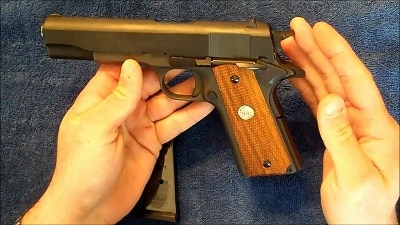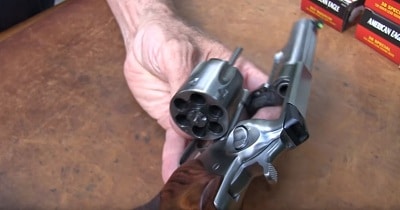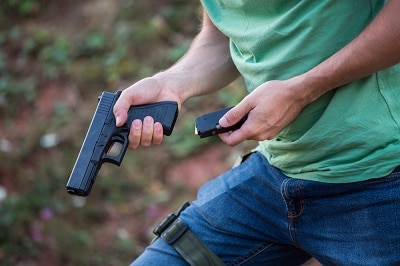Feeling confused about the difference between single action and double action?
By the end of this article, I will teach you the primary differences between the two, tell you the pros and cons of each, and say in what situation I prefer each.
To understand the difference between single action and double action, you must first understand exactly how a handgun works.
When you pull the slide of the handgun back, it allows for the magazine spring to push a bullet into the chamber. It also cocks the hammer of the firearm back.
Then, when you pull the trigger of the gun, it causes the hammer to snap forward, which pushes the firing pin inside the gun into the primer of the bullet cartridge.
When the firing pin strikes the primer, it ignites the propellant that will send the bullet flying down the barrel at a high rate of speed.
Make sense?
What the Hell Single Action vs Double Action is?
What is Single Action?
Single action is the exact chain of events that was previously described.

what is the single action gun (1911 Pistol)
When you pull the handgun slide back, the hammer is cocked and locked back.
When you pull the trigger of the gun, it drops the hammer, and the bullet is fired.
Many revolvers are single action, meaning you have to cock the hammer each time you shoot it.
What is Double Action?
In some semiautomatic pistols with an exposed hammer, you are able to decock the hammer.

What is double action weapon thespecialistsltd
In essence, you are able to ride the hammer forward slowly with your finger, without firing a bullet.
Similarly, some revolvers do not have an exposed hammer, and are double action each time you shoot it.
When you pull the trigger of a double action weapon, it serves two purposes. First, the trigger pull will cock the hammer. Second, the trigger pull will also drop the hammer.
As a result, double action weapons have a very long trigger pull.
Comparison between Single Action vs Double Action
Both single and double action weapons have their pros and cons.
So what is pros and cons of Single Action weapon?
- The biggest pro of a single action weapon is the shorter trigger pull. A shorter trigger pull will feel more natural to someone who is new to shooting. In my opinion, it is also a smoother shot, and you will be able to shoot more accurately.
- The biggest con of a single action revolver is that you have to cock the hammer between each shot. This will increase the amount of time it takes between shots. However, in a single action semiautomatic pistol, you only have to cock the hammer one time.
Pros and cons of Double Action
- The double action weapon are increased safety and faster shots in revolvers. Some people will argue that double action weapons are safer, as a result of the longer trigger pull. Because the trigger pull is longer, it is therefore more unlikely that you will inadvertently shoot the weapon.
- Double action revolvers will shoot faster than single action revolvers, as you don’t have to cock the hammer each time. However, double action semiautomatic pistols will shoot at the same rate as single action semiautomatic pistols.
- The con of a double action weapon is the long trigger pull. With some experience, it is easy to get used to, but at first, the long trigger pull will feel uncomfortable to most people.
- In striker fired double action semiautomatic pistols, such as a Glock, you will not feel this long pull. However, in hammer fired semiautomatic pistols, the long trigger pull is easily felt.
When Each Type is Best
In semiautomatic pistols, the difference between single action and double action is almost negligible.
Once you pull the slide back, it will usually cock the hammer. Then, it’s just a matter of whether you decock the hammer or not. At that point, the two weapons are extremely similar, in that all you have to do is pull the trigger. For that reason, I think the two can be used interchangeably.
Both single action and double action semiautomatic pistols can be used for hunting, casual shooting, and self-defense.
However, the difference becomes magnified when using a revolver.
In my opinion, single action revolvers are BETTER for hunting, and double action revolvers are better for self-defense.
For general shooting, either will work, but I would recommend single action. I prefer double action revolvers for self-defense since you don’t have to worry about cocking the hammer each time you shoot.
I prefer single action for general shooting, because it requires you to pay better attention. Since you have to cock the hammer each time, you are unlikely to make any careless mistakes.
Conclusion
Overall, the biggest difference between single action and double action weapons is what the trigger does when you pull it.
When you pull the trigger of a single action weapon, it simply drops the hammer. In a double action weapon, pulling the trigger both cocks and drops the hammer.
Both are effective mechanisms, and each of them have their pros and cons.

The second last sentence explained it perfectly. Thanks
I liked that you said that one reason to consider going to pistol class is that it will help you to learn how to use weaponry more safely. I have been thinking about getting a gun but I have been worried that it would be unsafe. I will be sure to receive training so that I can feel better about my ability to safely handling a weapon.
This is the best explanation of these concepts that I’ve read. Many thanks to you!
I find your explanations very easy to understand Thanks.
harleycrash@hotmail.com
That was the best explanation I have heard of the two. Anyone who asks me I will show them your description.
Thanks, Hdcrash
Really well explained. Do you have more articles on other topics? Thanks.
Another thing to consider is how dose the gun feel in your hand,
Just because I like how a freedom arms model 83 in single action feels,
Dose not mean a rugar single 10 22cal will feel the same,,
The perspective buyer may like the double action better,
As it is a different frame design….